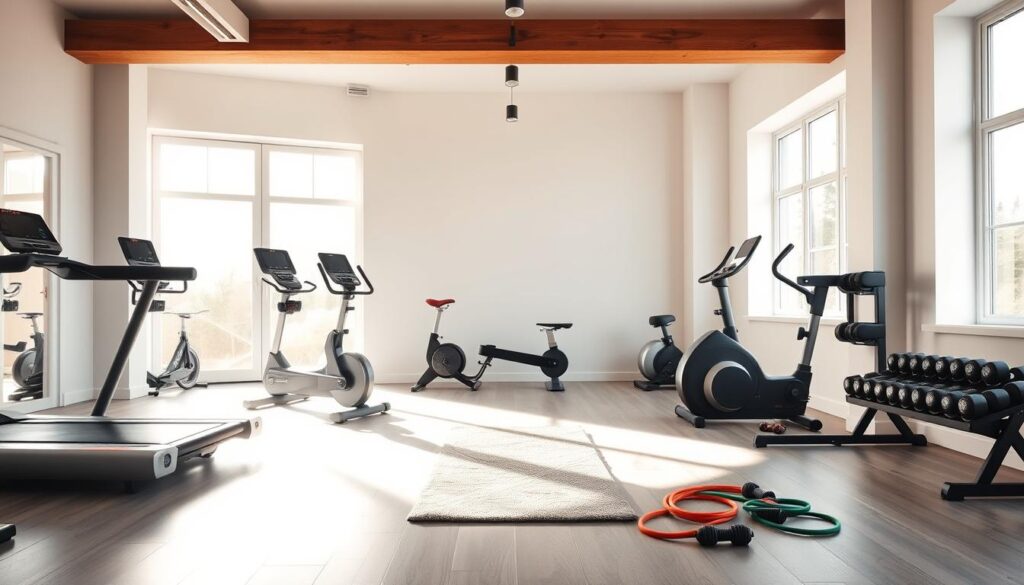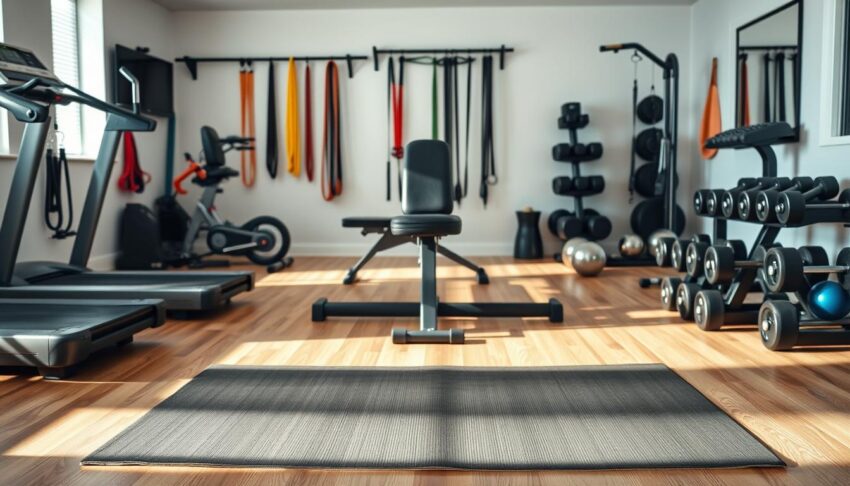Losing weight can be a challenging task, but with a well-structured workout plan, you can achieve your weight loss goals from the comfort of your own home.
A gym routine specifically designed for weight loss is not just about exercising; it’s about creating a comprehensive fitness plan that includes training strategies and nutrition support.
By following this guide, you’ll be able to create a personalized workout that suits your needs, maximizing your results and helping you achieve sustainable fat loss.
This article will cover the key components of an effective weight loss plan, including strength training, cardio strategies, and nutrition support, providing you with all the information you need to succeed.
Key Takeaways
- Understand the importance of a structured workout plan for weight loss.
- Learn how to create a comprehensive fitness plan that includes training strategies and nutrition support.
- Discover the benefits of following a proper gym routine for weight loss, including improved metabolism and sustainable fat loss.
- Get insights into the key components of an effective weight loss plan, including strength training and cardio strategies.
- Create a personalized workout plan that suits your needs and maximizes your results.
Understanding Weight Loss and Exercise
Exercise plays a pivotal role in weight loss by not only burning calories but also by preserving and building muscle mass. This dual effect is crucial for achieving and maintaining weight loss over time.
The Science Behind Weight Loss
Weight loss fundamentally comes down to creating a caloric deficit, where the body burns more calories than it consumes. Exercise is a key component in achieving this deficit. Different types of training, such as strength training, not only burn calories during the activity but also build metabolically active tissue. This means that the more muscle mass you have, the higher your resting metabolic rate will be, helping your body burn more calories at rest.
- Regular exercise contributes to a sustained caloric deficit.
- Strength training builds muscle, which is metabolically active and burns calories at rest.
- Studies show that individuals who include exercise in their weight loss plans are more likely to maintain their weight loss long-term.
Why Exercise is Essential for Sustainable Weight Loss
Exercise is not just about burning calories; it’s also about improving insulin sensitivity and other metabolic markers that make weight management easier. Furthermore, exercise has psychological benefits, including stress reduction and improved mood, which can increase adherence to healthy habits. By incorporating a mix of strength training and cardio exercise, individuals can achieve a more sustainable weight loss and improve overall health.
The combination of exercise and a balanced diet can lead to significant improvements in body composition and overall health. By understanding the role of exercise in weight loss and incorporating it into daily routines, individuals can achieve their weight loss goals more effectively.
Benefits of Creating a Home Gym Routine
Home workouts provide a convenient and effective way to lose weight without the need for expensive gym memberships. By establishing a gym routine at home, individuals can save time and money while achieving their fitness goals.
Convenience and Consistency Factors
One of the primary advantages of a home workout plan is the convenience it offers. Without the need to commute to a gym, individuals can allocate more time to their workout routine, potentially leading to more consistent and effective weight loss.
Cost-Effectiveness of Home Workouts
Home workouts eliminate the need for costly gym memberships. When comparing the cost of gym memberships over time to the one-time investment in basic home workout equipment, the financial benefits of home workouts become clear. Many effective weight loss exercises require little to no equipment, making home workouts accessible regardless of budget. Additionally, eliminating commuting costs and having the ability to reinvest time saved into longer or more frequent workouts further adds to the cost-effectiveness.

As noted by fitness experts, “A well-structured home workout plan can be just as effective as a gym routine, with the added benefits of convenience and cost savings.” By investing in a home gym routine, individuals can achieve their weight loss goals while maintaining a healthy and sustainable fitness regimen.
Essential Equipment for Your Home Gym Routine
A well-equipped home gym is the foundation of a successful weight loss journey. Having the right equipment can make your workouts more effective and enjoyable.
No-Equipment Options
Not everyone is ready to invest in equipment right away. Fortunately, there are several effective bodyweight exercise routines that require no equipment at all. These include push-ups, squats, lunges, and planks. You can also incorporate cardio exercises like jumping jacks and burpees into your routine.
Basic Equipment Recommendations
For those looking to enhance their training, basic equipment like dumbbells and resistance bands are excellent starting points. Dumbbells are versatile and can be used for a variety of strength training exercises, while resistance bands are lightweight and portable.
Advanced Equipment for Serious Home Gyms
For those ready to invest more, weights like kettlebells, a pull-up bar, and an adjustable bench can significantly expand your workout options. Kettlebells combine strength and cardio training in efficient, calorie-burning workouts. An adjustable bench increases the variety of exercises possible with your existing weights.
As emphasized by fitness experts, “The key to a successful home gym is not just about the quantity of equipment, but the quality and how it aligns with your fitness goals.” Investing in the right equipment is crucial for a productive gym routine.
Designing Your Gym Routine for Maximum Weight Loss
To achieve maximum weight loss, it’s crucial to design a gym routine that incorporates various training modalities. An effective weight loss routine combines strength training, high-intensity interval training (HIIT), and some steady-state cardio. This multifaceted approach ensures that you’re targeting different aspects of fitness, leading to more comprehensive results.
Setting Realistic Goals and Expectations
Before starting any workout plan, it’s essential to set realistic goals and expectations. This involves understanding your current fitness level, identifying your weight loss targets, and establishing a timeline. By setting achievable milestones, you can stay motivated and track your progress effectively.
Determining Workout Frequency and Duration
The frequency and duration of your exercise routine depend on your fitness goals, schedule, and current fitness level. For optimal weight loss, aim for at least 3-4 days of workout per week, with each session lasting between 45-60 minutes. This allows for adequate time to incorporate different types of training without overexerting yourself.
Balancing Different Types of Training
A well-rounded gym routine should include a mix of strength training, HIIT, and steady-state cardio. Strength training helps build muscle mass, which in turn boosts your metabolism. HIIT is excellent for burning calories and improving cardiovascular health, while steady-state cardio enhances endurance. By balancing these different types of training, you can create a synergistic effect that maximizes fat loss while preserving muscle.
To distribute different training types throughout your weekly workout schedule, consider allocating specific days for strength training, HIIT, and cardio. For example, you could do strength training on Monday and Thursday, HIIT on Tuesday and Friday, and steady-state cardio on Wednesday and Saturday. This balance ensures that you’re targeting different aspects of fitness without overdoing it.
Strength Training Fundamentals for Weight Loss
To maximize weight loss, it’s essential to understand the principles of strength training and how they impact your body. Strength training is not just about lifting weights; it’s about creating a sustainable routine that fosters muscle growth and fat loss.
Why Strength Training is Crucial for Fat Loss
Strength training is vital for fat loss because it helps build muscle mass, which in turn increases your resting metabolic rate (RMR). A higher RMR means your body burns more calories at rest, aiding in weight loss. Incorporating strength training into your workout routine can significantly enhance your weight loss efforts.
Rep Ranges and Weight Selection
Choosing the right rep range and weight is crucial for effective strength training. For weight loss, focusing on higher rep ranges (12-15 reps) with moderate weights can be beneficial, as it increases the caloric expenditure during and after your workout. However, it’s also important to incorporate lower rep ranges (6-8 reps) with heavier weights to build strength and muscle mass.
Rest Periods and Training Volume
Rest periods between sets significantly impact the intensity of your workout and the total calories burned. Shorter rest periods (30-60 seconds) increase the caloric burn during your workout, making it more efficient for weight loss. Training volume, calculated as sets x reps x weight, should be adequate to ensure results without risking overtraining. Aim for 10-15 sets per muscle group per week to strike a balance between progress and recovery.
- Rest periods between sets affect both the intensity of your workout and the total calories burned.
- Training volume should be optimized based on your weight loss goals.
- Guidelines for rest periods vary based on the intensity and purpose of each exercise.
- Balancing challenging workouts with proper form and technique is crucial.
- Gradually increasing training volume over time helps in continuing progress without overtraining.
Effective Cardio Strategies for Home Weight Loss
To achieve optimal weight loss, incorporating effective cardio strategies into your home gym routine is crucial. Cardiovascular exercise is a key component of a successful weight loss program, helping to burn calories and improve overall fitness.

HIIT vs. Steady-State Cardio
When it comes to cardio, there are two main types to consider: High-Intensity Interval Training (HIIT) and steady-state cardio. HIIT involves short bursts of high-intensity exercise followed by brief periods of rest, while steady-state cardio involves maintaining a moderate intensity over a longer period. Both methods have their benefits, and the best choice depends on your fitness goals and preferences.
For optimal weight loss, aim for 2-3 HIIT sessions and 1-2 steady-state cardio sessions per week. This balance can help you achieve a significant calorie burn while also improving cardiovascular health.
Incorporating Cardio Into Your Weekly Plan
Incorporating cardio into your weekly workout plan requires strategic scheduling around your strength training sessions. To avoid interference and maximize recovery, consider the following guidelines:
- Schedule cardio sessions on non-strength training days or after strength training sessions.
- Start with 2-3 cardio sessions per week and gradually increase frequency and intensity as your fitness improves.
- Adjust your cardio approach based on your personal preferences and response to different types of training.
- Incorporate cardio into your strength training sessions through circuit workout or supersets to maximize efficiency.
By incorporating cardio effectively into your weekly plan, you can enhance your weight loss journey and achieve your fitness goals.
Creating a Weekly Gym Routine Schedule

To achieve your weight loss objectives, it’s essential to design a weekly gym routine that suits your fitness level. A well-structured workout schedule can help you stay on track and ensure you’re making progressive gains. In this section, we’ll explore different weekly gym routine schedules tailored to various fitness levels.
3-Day Split for Beginners
For those new to working out, a 3-day split routine is an excellent starting point. This routine allows you to target major muscle groups without overexerting yourself. A typical 3-day split could include:
- Day 1: Chest and Triceps
- Day 2: Back and Biceps
- Day 3: Legs and Shoulders
This split routine helps you build a solid foundation and can be adjusted as you become more comfortable with your workout.
4-Day Split for Intermediate Level
As you progress in your fitness journey, you can move to a 4-day split routine. This allows for more focused training on specific muscle groups. An example 4-day split could be:
- Day 1: Chest and Triceps
- Day 2: Back and Biceps
- Day 3: Legs
- Day 4: Shoulders and Abs
This routine enables you to increase the intensity and volume of your workout, promoting further progress.
5-Day Split for Advanced Trainees
A 5-day push/pull/legs split is ideal for advanced trainees, allowing for maximum training volume and specificity. This routine involves:
- Day 1: Push (Chest, Shoulders, Triceps)
- Day 2: Pull (Back, Biceps)
- Day 3: Legs
- Day 4: Push (Chest, Shoulders, Triceps)
- Day 5: Pull (Back, Biceps)
This split routine is effective for those with advanced recovery capabilities, enabling them to train with higher frequency and intensity.
Incorporating various training techniques such as supersets, drop sets, and metabolic conditioning can further enhance your workout. It’s also crucial to monitor your recovery and adjust your training volume accordingly to prevent overtraining.
Full-Body Home Workout Plan for Weight Loss

Transform your body from the comfort of your home with a comprehensive full-body workout routine designed for weight loss. This plan is tailored to help you achieve your fitness goals without the need for expensive gym equipment or memberships.
Warm-Up Routine
Begin with a dynamic warm-up to prepare your muscles for the workout ahead. This should include light cardio such as jogging in place or jumping jacks for 5 minutes, followed by dynamic stretches like leg swings and arm circles.
Core Exercises
Your core is the foundation of your workout. Include exercises like planks, Russian twists, and leg raises to target your core muscles. Aim for 3 sets of 12-15 reps for each exercise.
Upper Body Movements
For your upper body, incorporate exercises such as push-ups, dumbbell rows, and tricep dips using a chair or bench. Perform 3 sets of 12-15 reps.
Lower Body Exercises
Target your lower body with squats, lunges, and calf raises. Again, aim for 3 sets of 12-15 reps for each exercise to effectively work your muscles.
Cool-Down Stretches
Finish your workout with a cool-down session involving static stretches to improve flexibility and aid in recovery. Focus on major muscle groups worked during the session.
A proper cool-down with static stretching improves flexibility, reduces muscle soreness, and accelerates recovery between workouts. Allocate 5 minutes to stretching, holding each stretch for 20-30 seconds.
Progressive Overload: The Key to Continued Weight Loss
Progressive overload is a crucial training principle that helps you avoid plateaus and achieve sustained weight loss. It’s about gradually increasing the intensity of your workout routine to challenge your muscles and boost metabolism.
Methods to Increase Workout Intensity
There are several ways to increase the intensity of your workout. You can:
- Increase the weight or resistance you’re using
- Boost the number of reps or sets
- Improve the frequency of your training sessions
- Decrease rest time between sets
For example, if you’re doing a routine that involves squats, you can increase the weight you’re lifting or do more reps to challenge yourself.
When and How to Progress Your Routine
You should progress your routine when you can complete all prescribed reps with good form for 2-3 consecutive workouts, typically every 2-4 weeks. To do this effectively, track your workouts systematically. A sample progression plan might look like this:
- Weeks 1-4: 3 sets of 8-12 reps
- Weeks 5-8: 3-4 sets of 10-15 reps with increased weight
- Weeks 9-12: 4 sets of 12-15 reps with further increased weight
It’s also important to incorporate “deload weeks” every 4-6 weeks to prevent plateaus and overtraining. Balancing progress with proper recovery is key to sustainable weight loss without injury.
Nutrition Strategies to Support Your Weight Loss Gym Routine
Nutrition plays a vital role in enhancing the effectiveness of your weight loss gym routine. A well-balanced diet not only fuels your workouts but also supports recovery and muscle maintenance.

Pre and Post-Workout Nutrition
Proper nutrition before and after workouts is crucial for optimal performance and recovery. Consuming a mix of carbohydrates and protein before a workout can help provide energy and reduce muscle damage. After a workout, a meal or snack rich in protein and carbohydrates can aid in recovery and muscle repair.
For example, having a banana with peanut butter before a workout can provide sustained energy, while a post-workout smoothie with protein powder, berries, and almond milk can support muscle recovery.
Hydration and Overall Diet Considerations
Hydration is often overlooked but is critical for both workout performance and recovery. Aim to drink at least 8-10 glasses of water per day, and consider increasing this amount based on the intensity and duration of your workouts.
A diet high in protein and fiber can support weight loss and muscle maintenance. Include a variety of whole foods such as lean meats, fish, eggs, vegetables, and whole grains in your diet. Avoid excessive intake of processed foods and sugars.
As noted by a fitness expert, “A well-balanced diet is the foundation of a successful fitness journey.” This emphasizes the importance of making informed nutrition choices to support your gym routine.
“You don’t have to be great to start, but you have to start to be great.” – Zig Ziglar
To stick to a supportive nutrition plan, plan your meals in advance, and prepare healthy snacks. Common nutrition mistakes to avoid include skipping meals, not consuming enough protein, and neglecting hydration.
Tracking Progress and Staying Motivated
To achieve your weight loss goals, it’s vital to track your progress and stay motivated. A well-structured home gym routine is just the beginning; monitoring your advancements and maintaining enthusiasm are crucial for long-term success.
Effective Ways to Measure Success
Measuring success is not just about stepping on the scale. Effective ways to track progress include monitoring your workout routine, taking body measurements, and tracking changes in your overall health and fitness levels. You can also use progress photos and track your workout progress by monitoring the weights you lift and the number of repetitions you complete.
- Track changes in body fat percentage
- Monitor improvements in cardiovascular health
- Record increases in strength and endurance
Overcoming Plateaus and Maintaining Motivation
Weight loss plateaus are a normal part of any weight loss journey. To overcome them, it’s essential to adjust your routine and challenge yourself. This can involve changing your workout intensity, trying new exercises, or reassessing your nutrition plan. Setting goals and creating a support network can also help maintain motivation.
To maintain motivation, focus on setting process-based goals rather than just outcome-based goals. This helps in maintaining consistent motivation by acknowledging and celebrating small achievements along the way.
Creating accountability systems, such as workout buddies or fitness trackers, can also help sustain long-term motivation and adherence to your weight loss goals.
Common Mistakes to Avoid in Your Home Gym Routine
A successful weight loss journey at home involves not just exercising regularly, but also sidestepping mistakes that can derail your progress. While a well-structured workout routine is crucial, several external factors can significantly impact your weight loss results.
Training Errors That Hinder Weight Loss
One of the most common training errors is overtraining. While regular exercise is essential, excessive workout frequency or intensity can lead to fatigue, injury, and ultimately, a plateau in weight loss. It’s also important to balance different types of training, including strength and cardio exercises, to ensure overall fitness and maximize weight loss.
- Insufficient variation in your workout routine can lead to stagnation.
- Overtraining can result in injury and burnout.
- Poor form and technique can reduce the effectiveness of your workouts.
Recovery and Lifestyle Mistakes
Factors outside the gym, such as sleep, stress, and recovery, play a significant role in weight loss. Inadequate sleep can disrupt hormones that regulate hunger, leading to increased calorie intake. High levels of stress can also contribute to weight gain by promoting fat storage.
Lifestyle habits, including diet and alcohol consumption, can also undermine weight loss efforts. For instance, compensatory eating after workouts can negate the calorie deficit achieved through exercise. Ensuring adequate recovery, managing stress, and maintaining a balanced diet are crucial for successful weight loss.

To maximize weight loss results, it’s essential to adopt a holistic approach that includes a balanced diet, regular exercise, adequate sleep, and effective stress management. By avoiding common mistakes and focusing on overall lifestyle changes, individuals can achieve sustainable weight loss.
Conclusion: Building a Sustainable Weight Loss Journey
A well-designed home gym routine is essential for those seeking to lose weight and maintain overall fitness. Throughout this article, we’ve covered the key components of an effective weight loss routine, from understanding the science behind weight loss to designing a comprehensive workout plan.
To achieve your goals, it’s crucial to be consistent and patient, as sustainable weight loss results take time. Start with beginner routines and gradually progress as your fitness level improves. Remember, the most effective routine is one that you can stick to consistently over time.
View your weight loss journey as a positive lifestyle change, celebrating non-scale victories and focusing on the many health benefits you’re gaining. By developing a home gym routine, you’ll cultivate skills and habits that will serve you well beyond your initial weight loss goals. Take the first step today and start your fitness journey towards a healthier, more sustainable you.
